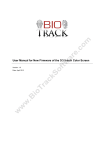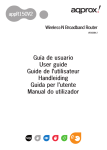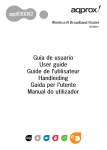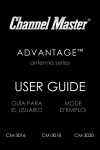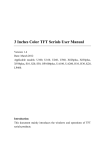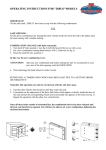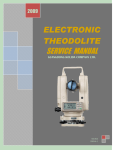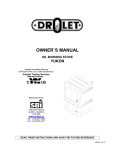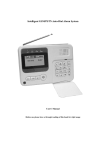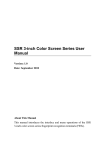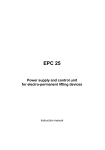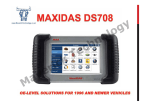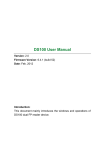Download LX20 User Manual
Transcript
LX20 User Manual Version: 1.0 Date: April. 2014 Scope: SSR selfservice attendance terminal with a firmware version later than V3.0 About This Manual This document describes the GUIs and menu operations of the selfservice attendance terminal. About this manual Ø Not all the devices have the function withê. The real product prevails. Ø The photograph in this manual may be different from that of the real product. The real product prevails. Contents CONTENTS 1 Instruction for Use..................................................................................................................................................... 1 1.1 Recommended Operation Steps...................................................................................................................... 1 1.2 Finger Placement............................................................................................................................................ 1 1.3 Verification Modes........................................................................................................................................... 1 1.3.1 Fingerprint Verification........................................................................................................................... 1 1.3.2 Password Verification ............................................................................................................................ 2 1.2.4 Card Verificationê................................................................................................................................. 3 2 Main Menu ............................................................................................................................................................... 4 3. User Management ................................................................................................................................................... 5 3.1. Add a User..................................................................................................................................................... 5 3.1.1 Enter a User ID and Name..................................................................................................................... 5 3.1.2 Enroll a Fingerprint ................................................................................................................................ 5 3.1.3 Enroll a Password ................................................................................................................................. 6 3.1.4 Enroll an Card ê ................................................................................................................................... 6 3.1.5 Select Department and Privilege Settings............................................................................................... 6 3.2 User Management........................................................................................................................................... 6 3.2.1 Search a User ....................................................................................................................................... 7 3.2.2 Query a Record..................................................................................................................................... 7 3.2.3 Edit a User ............................................................................................................................................ 8 3.2.4 Delete a User ........................................................................................................................................ 8 3.2.5 Add a User ............................................................................................................................................ 8 4 Department Set ........................................................................................................................................................ 9 4.1 Add a Department........................................................................................................................................... 9 4.2 Edit a Department ........................................................................................................................................... 9 4.3 Delete a Department ....................................................................................................................................... 9 5 Shift Set ..................................................................................................................................................................10 5.1 Attendance Rule ............................................................................................................................................10 5.2 Shift Setting ...................................................................................................................................................11 5.3 Schedule .......................................................................................................................................................11 5.3.1 Departmentbased Scheduling..............................................................................................................11 5.3.2 Individualbased Scheduling .................................................................................................................12 6 Report Management ................................................................................................................................................14 6.1 Download Att. Report .....................................................................................................................................14 6.2 Download Att. Setting Report..........................................................................................................................15 6.3 Set Setting Reports ........................................................................................................................................17 7 System Setting ........................................................................................................................................................18 7.1 System Setting...............................................................................................................................................18 7.2 Date/Time......................................................................................................................................................19 7.3 Timing State Switching Setting .......................................................................................................................19 7.4 SMS Setting...................................................................................................................................................20 7.4.1 Add an SMS Message ..........................................................................................................................20 7.4.2 Edit an SMS Message ..........................................................................................................................21 I Contents 7.4.3 Delete an SMS Message ......................................................................................................................21 7.5 Daylight Saving Time (DLST) Settingê...........................................................................................................22 7.6 Bell Settings...................................................................................................................................................22 7.7 Work codeê ..................................................................................................................................................23 7.7.1 Add a Work Code .................................................................................................................................24 7.7.2 Edit a Work Code .................................................................................................................................24 7.7.3 Delete a work code...............................................................................................................................24 7.7.4 Use a Work Code .................................................................................................................................25 7.8 Update firmware.............................................................................................................................................25 7.9 Reset Opts.....................................................................................................................................................25 8 Data Management ...................................................................................................................................................26 8.1 Download/Upload...........................................................................................................................................26 8.2 Delete/Clear...................................................................................................................................................26 9 Record Query ..........................................................................................................................................................27 10 System Information................................................................................................................................................28 11 Appendix................................................................................................................................................................29 USB Client...........................................................................................................................................................29 T9 input ...............................................................................................................................................................29 Quick Query of Attendance Records.....................................................................................................................30 SelfService Attendance Terminal FAQs...............................................................................................................31 Statement on Human Rights and Privacy..............................................................................................................37 EnvironmentFriendly Use Description..................................................................................................................38 II SelfService Attendance Terminal User Manual 1 Instruction for Use 1.1 Recommended Operation Steps Step 1: Set a department (not required if the default department is used). For details, see 4 "Department Set." Step 2: Enroll users. For details, see 3 "User Management." Step 3: Set attendance rules (not required if the default rule is used). For details, see 5.1 "Attendance Rule." Step 4: Set shifts (not required if the default shift is used). For details, see 5.2 "Shift Setting." Step 5: Arrange schedules of employees (not required if the default schedule is used). For details, see 5.3 "Schedule." Step 6: Record employees' attendance. Check that the device time is precise and start attendance. Step 7: Download and review reports. For details, see 6.1 "Download Att. Report." 1.2 Finger Placement Recommended fingers: The index finger, middle finger or the ring finger; the thumb and little finger are not recommended (because they are usually clumsy on the fingerprint collection screen). 1) Proper finger placement: The finger is flat to the surface and centered in fingered guide. 2) Improper finger placement: Not flat to the surface Offcenter Offcenter Slanting 1.3 Verification Modes 1.3.1 Fingerprint Verification 1: N Fingerprint Verification The terminal compares current fingerprint collected by the fingerprint collector with all fingerprint data on the terminal. Press your finger on the fingerprint collector by adopting the proper finger placement. For details, see 1.2 Finger Placement. 1 1 Instruction for Use When verification successful, When verification failed, an interface shown above. an interface shown above. 1:1 Fingerprint Verification In the 1:1 fingerprint verification mode, the terminal compares current fingerprint collected through the fingerprint collector with that in relation to the user ID entered through keyboard. Adopt this mode only when it is difficult to recognize the fingerprint. Enter the user ID using keypad on the initial interface. Then press OK. Place the enrolled finger properly on the fingerprint sensor. When verification successful, an interface shown above. When verification failed, an interface shown above. Notes: 1. If it says that the enroll number is wrong, it means that there is no such number or the employee doesn’t enroll password. 2. If the device says "Please press again", place the finger on the fingerprint sensor again. You can try another 2 times by default. If it fails after 2 times, return Step 1 for second operation. 1.3.2 Password Verification In the password verification mode, the terminal compares the password entered with that in relation to the user ID. Enter the user ID and PWD using keypad on the initial interface. Then press OK. When verification successful, an interface shown above. When verification failed, an interface shown above. Notes: If the device says "Invalid ID", enter the password again. You can try another 2 times by default. If it fails after 2 times, return Step 1 for second operation. 2 SelfService Attendance Terminal User Manual 1.2.4 Card Verificationê Some devices have an embedded ID or Mifare card module, providing the verification function. A device compares the read card ID with all card IDs enrolled in the device during verification. Note: If a device is connected to a computer through a USB cable, the Mifare card of the device is unavailable and a text prompt message is displayed on the initial interface. The Mifare card restores after the If the verification is successful, an If the verification is not successful, device is disconnected from the computer. interface as shown above. an interface as shown above. Notice: The card area in some devices is round the fingerprint sensor and others are round the keyboard. 3 2 Main Menu 2 Main Menu The selfservice attendance terminal that integrates the prevalent SSR technology in Europe and America is launched to reduce management costs effectively, provide convenience for employees, and minimize the requirement for computer skills of users. The device allows setting attendance rules, shifts, and schedules for employees, without the need for attendance software. Users can download attendance reports for review and statistics. This menu item allows you to add, browse, and manage user information, including the employee ID, name, fingerprint, password, card ID, department, and rights. You can add, edit, or delete basic information about User Dept.set employees. This menu item allows you to browse department information, add, edit, or delete department IDs or names. This menu item allows you to set attendance rules and required shifts and to arrange schedules for Shift set employees. The device supports a maximum of 24 shifts. This menu item allows you to download statistical reports of attendance or attendance setting reports to a USB flash drive or SD card, or to upload attendance setting reports in which shifts are set and employees' Report schedules are arranged. The device gives priority to the schedules in an attendance setting report. This menu item allows you to set systemrelated parameters, including the basic parameters, Date/Time, Timing State Switching Setting, SMS Setting and so on, to enable the terminal to meet user requirements System to the greatest extent in terms of functions and display. This menu item allows you to upload or download user data or attendance data, delete attendance data and all user data, and revoke management rights. Data Mgt. Through an SD card or a USB disk, import user information and attendance data from the attendance machine to related software or other fingerprint recognition devices. Record This menu item allows you to easily query the attendance records saved on the device. This menu item allows you to check the storage status as well as version information of the device. Sys. Info. 4 SelfService Attendance Terminal User Manual 3. User Management 3.1. Add a User Through this submenu, you can browse the user information stored on the terminal, including the user ID, name, fingerprint, password, department, and user role. Press M/OK on the initial interface. Select User and press OK. Select Add user and press OK. 3.1.1 Enter a User ID and Name The terminal automatically allocates an ID starting from 1 for every user in sequence. If you use the ID allocated by the terminal, you may skip this section. For details of operations on keyboard interface, see T9 input. The terminal supports the 23character names by default. Select User ID. Press ▼ to select Name. Enter the user ID using keypad, Press M/OK to open input method. then press OK. Press▲/▼to switch input method and enter the Name. 3.1.2 Enroll a Fingerprint Press ▼ select Enroll FP and press M/OK. Place your finger on the fingerprint sensor properly. For details, see 1.2 Finger Placement. Place the same finger on the fingerprint collector for three consecutive times correctly until enrollment succeeds. Note: If the enrollment fails, the system will display a prompt message and return to the [Enroll Fingerprint] interface. In this case, you need to repeat the operations of step 2. 5 3. User Management 3.1.3 Enroll a Password The FFR terminal supports the 1 to 8digit passwords by default. Press ▼ to select Enroll PWD. Press OK. Enter a password using keypad and Reenter the password, press M/OK. 3.1.4 Enroll an Card ê Some devices have an embedded ID or Mifare card module, providing the verification function. Press▼ to select Enrolling Card and press OK. Swipe your ID card properly in the swiping area. “Read Successfully! 3.1.5 Select Department and Privilege Settings Administrators: An administrator is granted rights to operate all menus in addition to the fingerprint and passwordbased attendance recording. Ordinary users: An ordinary user is only allowed to record attendance through fingerprint and password verification and query attendance records. Press ▼ to select Dept.. Press OK to select department. Press ▼ to select Purview. Press OK to select Purview. Finally, press ▲/▼to select M/OK and press M/OK. Till now, a user is added. 3.2 User Management Generally the user information stored on the device needs to be modified in the wake of the personnel changes in a company. To facilitate modification of user information, our device allows users to add, delete, query and modify user 6 SelfService Attendance Terminal User Manual information conveniently. Press M/OK on the initial interface. Select User and press OK. Select User Mgt. and press OK. Enter the user ID, such as 3, and press OK. The cursor to the user to be queried. 3.2.1 Search a User User Mgt. interface Press 1 to enter Note: “#” as shown in the figure above means the user is an administrator, and “*” means the user has already enrolled a password or card. 3.2.2 Query a Record Press ▲/▼ to select a user and press 2. Press ▲/▼ to scroll the attendance Press M/OK to query detailed record row by row. Press / to information of an employee: scroll the attendance record page by page. Notes displayed at the bottom of the screen explain all letter meanings. Verification: validation status. F: fingerprint verification. P: password verification I: Card verification Status: attendance status. 0: checkin 1: checkout 4: overtime checkin 7 5: overtime checkout 3. User Management 3.2.3 Edit a User Press ▲/▼ to select a user and The User ID cannot be modified, and press M/OK. the other operations are similar to those performed to add a user. 3.2.4 Delete a User The option “Delete user” is in either of the following cases to delete all information of an employee from the popular colorscreen FRT: 1) The fingerprint or password of this employee is no longer required. 2) This employee has resigned. Press▲/▼ to select a user and Press M/OK to delete the user or press 0. ESC to return without deleting. Note: Deleting a user will not result in the deletion of the user’s attendance records which can be downloaded to related software for query. 3.2.5 Add a User The Add user option is used to facilitate administrators to add users. For details, see 3.1. Add a User. 8 SelfService Attendance Terminal User Manual 4 Department Set Browse department information. Add, edit, or delete department IDs or names. Press M/OK on the initial interface. Select Dept.set and press OK. Enter Department set interface as shown as figure. 4.1 Add a Department No.: The attendance machine automatically assigns work IDs for departments that start from 1 and increase sequentially. Dept.: Enter the department name Press 1 to enter Add Dept. interface. Enter the department name using the T9 input method. Press / to select Shift Name and press M/OK. 4.2 Edit a Department Press ▲/▼ to select a department The Edit department operations are to be edited and press M/OK. similar to those performed to add department. 4.3 Delete a Department Press ▲/▼ to select a department Press M/OK to delete the user or and press 0. ESC to return to the User Mgt. interface without deleting. 9 using the T9 input method. (For detailed operations, see T9 input.) 5 Shift Set 5 Shift Set This menu item allows you to set attendance rules and required shifts and to arrange schedules for employees. Press M/OK on the initial interface. Select Shift set and press OK. Select Attendance Rule and press OK. 5.1 Attendance Rule All attendance statistics are collected based on attendance rules. Attendance rules regarding how to calculate late arrival and early leave and how to arrange schedules need to be set first. Once set, they should not be modified from time to time because a modification may cause deviation in attendance record and a modification in the middle of a month may even disarrange the schedules. Schedule Type: Departmentbased scheduling and individualbased scheduling are supported. If a company uses one timetable, only one department needs to be set and departmentbased scheduling is recommended. If departments have their respective timetables, departmentbased scheduling is recommended. If employees may take different shifts, individualbased scheduling is recommended. Default Shift: When individualbased scheduling is used, employees who are not scheduled take the default shift. Press ▲/▼ to move the cursor to a desired option. Enter a desired value in the entry box using the numeric keypad. Press ◄/► in the scroll box to switch to the desired value. After finishing the setting, press OK to save your settings and go back to the previous interface. Press ESC to cancel your settings and go back to the previous interface. Set attendance rules by referring to the instructions in the text box on the right. Press ▲/▼ to select M/OK. Press M/OK for saving. 10 SelfService Attendance Terminal User Manual 5.2 Shift Setting Press ▼ to select Shift setting, Press M/OK Press ▲/▼ to select a shift from the Press ▲/▼ to choose list, and press ► to display the Edit corresponding shift attributes. Enter shift interface the time using the numeric keypad. Press M/OK Shift setting: The device supports a maximum of 24 shifts including two default shifts (shift 1 and shift 2). All shifts can be edited and a single shift includes three time ranges at most. 5.3 Schedule As the basis of attendance calculation, shifts should be set based on the actual condition of a company. If no shift is set, the system makes attendance calculations based on default shifts set in attendance rules. Press M/OK on the initial interface. Select Shift set and press OK. Select Schedule and press OK. 5.3.1 Departmentbased Scheduling The Schedule type in Attendance Rule is Department shifting. 1.Scheduling Records Query Press 1 to enter Scheduling records Query Enter a No. and press OK. Enter 1 as shown as in figure. 11 The department's scheduling records as shown as in figure. 5 Shift Set 2.Edit Schedule Press▲/▼ to select a shift then press M/OK. Press / to select Shift Name, like: Shift2, Press M/OK. When editing successful, an interface shown above. 5.3.2 Individualbased Scheduling The Schedule type in Attendance Rule is Personal shift. 1. Add Schedule Press 3 to enter Add Schedule interface. Enter an ID. The device automatically displays the name. Press ▲/▼ to select Shift Name and then press M/OK. When adding successful, an interface shown above. Press / to select Shift Name, like Shift 2, press ▲/▼ to select M/OK then press M/OK. When adding successful, an 2. Edit Schedule Press▲/▼to select a shift then press M/OK. interface shown above. Note: The User ID cannot be modified, and the other operations are similar to those performed to add a shift. 3. Scheduling Records Query 12 SelfService Attendance Terminal User Manual Press 1 to enter Scheduling records Query Enter an ID number and press OK. Enter 3 as shown as in figure. 4. Delete a shift Press ▲/▼ to select a shift then press 0. Press M/OK to delete. Press ESC to exit 13 The user's scheduling records as shown as in figure. 6 Report Management 6 Report Management Note: The schedules in attendance setting reports have priority over those set on the device in attendance calculation. Note: The attendance machine downloads information onto the USB disk when a USB disk and an SD card are inserted simultaneously. Press M/OK on the initial interface. Select Report and press M/OK. Select Download Att. Report and press M/OK. Downloading...... Data download succeed! Press M/OK to take out the USB disk or SD card. 6.1 Download Att. Report Enter the start and end dates using keypad then press OK. The SSRTemplateS.xls shall be stored in the USB disk or SD card. The schedule information, statistical report of attendance, attendance Record Report, Exception Statistic Report and card report can be viewed on a PC. The following reports show the preceding information: To make reports more understandable, a report containing twoday attendance records of four employees is provided as an example. Schedule Information Report: The report allows you to view schedule records of all employees. Statistical Report of Attendance: The report allows you to query attendance of each person in a specified period. Salaries can be calculated directly based on this report. Note: The unit of Work hour and Overtime hour in the Statistical Report of Attendance is HH:MM. For example, 17:50 indicates that the onduty time is 17 hours and 50 minutes. 14 SelfService Attendance Terminal User Manual Attendance Record Report: The report lists the daily attendance records of all employees within a specified period. Exception Statistic Report: The report displays the attendance exceptions of all employees within a specified period so that the attendance department handles the exceptions and confirm them with the employees involved and their supervisors. Card Report: The report can substitute for clockbased cards and can be sent to each employee for confirmation. 6.2 Download Att. Setting Report If shifts are complex or the shifts of a person are not fixed, it is recommended that the attendance setting report be downloaded and shifts and schedules be set for employees in the attendance setting report. 15 6 Report Management Press ▼to select Download Att. Report then press OK. Downloading...... Data download succeed! Press M/OK to take out the USB disk or SD card. Open the setting "AttSettingE.xls" in the USB disk or SD card on a PC. Set the Shift in the Attendance setting report. The shifts that have been set on the attendance machine shall be displayed. (For more details, see 5.2 Shift Setting) You can modify the 24 shifts and add shifts. After modification, the shifts shall prevail on the attendance machine. For more details, see "How to arrange schedules using the attendance setting report" in the "SelfService Attendance Terminal FAQs." Enter the on/off duty time in the corresponding columns, where the First time zone shall be the on/off duty time of Time 1 5.2 Shift Setting in and the Second time zone shall be the on/off duty time of Time 2. For the correct schedule time format, see "What is the correct time format used in the setting reports" in the "SelfService Attendance Terminal FAQs." Set a schedule setting report Enter the ID, Name, and Department respectively on the left of the Schedule Setting Report. Set shifts for employees on the right of the Schedule Setting Report, where shifts 1–24 are shifts those set in the Attendance setting report and shift 25 is for leave and shift 26 is for out. Notes: 1. The shifts of only 31 days can be arranged in one schedule setting report. For example, if the scheduling date is 201211, the schedule setting report contains the schedules of 31 days after 201211, that is, schedules from 201211 to 2012131. If the scheduling date is 201216, the schedule setting report contains the schedules of 31 days after 201216, that is, schedules from 201216 to 201225. 2. If no schedule setting report is set, all employees use the report 1 by default from Monday to Friday. 16 SelfService Attendance Terminal User Manual 6.3 Set Setting Reports Select Upload Att. Setting Report then press OK. Uploading table…… Data upload succeed! Press M/OK to take out the USB disk or SD card. The employee information, shifts, and departments in the setting reports can be viewed after you select User, Dept set, and Shift set respectively on the initial interface. Then you can view the information of employees, shifts, and departments either on relevant interfaces or in downloaded standard reports. Note: If the schedule time format is incorrect, an interface shown in the following figure will be displayed: For the correct schedule time format, see "What is the correct time format used in the setting reports" in the "SelfService Attendance Terminal FAQs." Press M/OK. Reupload the attendance setting report after modification. 17 7 System Setting 7 System Setting 7.1 System Setting Set system parameters to meet user requirements to the greatest extent in terms of functions and display. Press M/OK on the initial interface. Select System and press M/OK. Select System and press M/OK. Move the cursor to the desired option by pressing ▲/▼. Enter a desired value in the entry box by using the keypad. Press in the scroll box to switch to the desired value. After finishing the setting, press M/OK to save your settings and return to the previous interface. Press ESC to cancel your settings and return to the previous interface. Set system parameters. Threshold (1:1): This option is used to set the extent of matching between an input ID/fingerprint and that stored in templates in the ID and fingerprint identification mode. Threshold (1: N): This option is used to set the extent of matching between an input ID/fingerprint and all those stored in templates. The recommended thresholds are as follows: Match threshold FRR FAR 1:N 1:1 High Low 45 25 Medium Medium 35 15 Low 25 10 High Date Format: This option is used to set the time format displayed on the initial interface of the popular colorscreen FRT. Select a desired date format by pressing . The popular colorscreen FRT supports 10 date formats: YYMMDD, YY/MM/DD, YY.MM.DD, MMDDYY, MM/DD/YY, MM.DD.YY, DDMMYY, DD/MM/YY, DD.MM.YY and YYYYMMDD. Key Voice: Set whether to generate a beep sound in response to every keystroke by pressing . Select Y to enable the beep sound, and select N to mute. Voice prompts: Set whether to generate a voice prompt in response to every operation by pressing . Retry Period: If a user’s attendance record already exists and the user signs in again within the specified period (unit: minute), his/her second attendance record will not be stored. (Value scope: 0–60. 0: Save all the records passing the verification.) Log Alert: When the available space is insufficient to store the specified number of attendance records, the popular colorscreen FRT will automatically display a warning message. (Value scope: 1─99. 0: No warning message is displayed 18 SelfService Attendance Terminal User Manual when the free space is zero.) Lan: You can select a language for the device based on your requirements. Sensitivity: Set the fingerprint collection sensitivity. It is recommended to use the default value Medium. When dryness results in slow reactions of the fingerprint collector, you may set this option to High to enhance the fingerprint collector's sensitivity. When high humidity results in illegible fingerprint images, you may set this option to Low. Volume: This option is used to adjust the volume of sound. Select a desired volume by pressing . Workcode: This option is used to set whether to enable the work code function. 7.2 Date/Time This menu item allows you to calibrate the date and time of the device. Press M/OK on the initial interface. Select System and press M/OK. Select Date/Time and press M/OK. Note: The date and time of the popular colorscreen FRT must be set accurately to ensure the accuracy of attendance time. Enter the desired value by using the keypad. Press M/OK to save. 7.3 Timing State Switching Setting When it comes the set times, the attendance machine will automatically switch its attendance state. The current attendance state is shown on the initial interface. Note: The attendance status is downloaded together with attendance records. Users can view the attendance status by using attendance software. The attendance status does not affect attendance calculation, which is based on the preset shift time. Press M/OK on the initial interface. Select System and press M/OK. 19 Select Auto Switch and press M/OK. 7 System Setting Press ▲/▼ to select the item and press M/OK. Set parameters by referring to the instructions in the following text box and press M/OK. As shown in the preceding figure, when the time reaches 07:00, the attendance status switches to CheckIn. Press ▲/▼ to switch among the entry boxes. Enter the switch time using the numeric keypad and the switch name using the T9 input method. Press ◄/► to choose a state. After the setting is complete, press M/OK to save and go back to the previous interface. Press ESC to cancel the setting and go back to the previous interface. 7.4 SMS Setting The menu item allows you to add, edit, view, and delete SMS messages. Press M/OK on the initial interface. Select System and press M/OK. Select SMS and press M/OK. Press M/OK to open input method. Press▲/▼ to switch input method and enter the Start, Valid and Type. Press M/OK to save. When adding successful, an interface shown above. 7.4.1 Add an SMS Message Press 3 to enter Add a SMS interface. Operation description When the cursor hovers over the text box, press the shortcut key to enable the T9 input method and then enter the message content. You can press ▲/▼ to switch among the entry boxes of different options and press ◄/► to choose a desired value or enter one using the keypad. If Personal is chosen, press Assign to assign an SMS message to desired employees. 20 SelfService Attendance Terminal User Manual Operation: Press 3 to enter Add a SMS interface. Press M/OK to select User, press M/OK to select √ and press ESC to return. When adding successful, an interface shown above. 7.4.2 Edit an SMS Message On the SMS Setting interface, press ▲/▼ to choose an SMS message and press OK to edit it. The operations of SMS message editing are the same as those of SMS message adding. 7.4.3 Delete an SMS Message On the SMS Setting interface, press ▲/▼ to choose an SMS message and then press 0 to delete it and all information relating to the SMS message. Press▲/▼to select a SMS then Press M/OK to delete. press 0. Press ESC to exit 7.4.4 View an SMS Message v View public SMS messages When is shown on the initial interface, press M/OK to view. v View the currentlyvalid public messages, as shown as in figure. View personal SMS messages After a user is successfully verified (multiple verification modes can be used and the following uses fingerprint verification as an example), the user’s personal messages will show up on the screen, as shown in the following figure. 21 7 System Setting Successfully verified Show user’s personal messages Note: SMS messages only show up for 30 seconds, during which you can close current display interface so as to enter the Verification interface. 7.5 Daylight Saving Time (DLST) Settingê The Daylight Saving Time is a widely used system of adjusting the official local time forward to save energy. The uniform time adopted during the implementation of this system is known as the DLST. Typically clocks are adjusted forward one hour in the summer to make people early to bed and early to rise so as to make full use of illumination resources and save electricity. Clocks are adjusted backward in autumn. The specific DLST regulations vary with countries. To meet the DLST requirement, the FRT supports the DLST function to adjust forward one hour at ×× (Hour): ×× (Minute) ×× (Day) ×× (Month) and backward one hour at ×× (Hour): ×× (Minute) ×× (Day) ×× (Month).For example, adjust the clock forward one hour at 08: 00 on April 1, and backward one hour at 08: 00 on October 1. (As shown in the above figure) Press M/OK on interface. Press / to ON. the initial Select System and press M/OK. Select DST and press M/OK. to set the DST option Press ▲/▼ to select among the entry boxes, using the numeric keypad to enter the start and end time of DLST, press M/OK to save Note: The end time of DLST cannot be set to next year. More specifically, the end time must be later than the start time in the same year. 7.6 Bell Settings Lots of companies need to ring their bells to signal the start and end of work shifts, and they usually manually ring their bells or use electric bells. To lower costs and facilitate management, we integrate the time bell function into the FRT. You can set the alarm time and duration for ringing the bell based on your requirements, so that the attendance machine will 22 SelfService Attendance Terminal User Manual automatically play the selected ring tone, and stop playing the ring tone after the set duration. Press M/OK on the initial interface. Select System and press M/OK. Select Bell and press M/OK. Press▲/▼to select a bell then press M/OK. Press▲/▼and M/OK to select items. When editing successful, an When the setting is completed, interface shown above. press OK to save the setting and exit. Time: Set a time point of one day or several days from Sunday to Saturday when the attendance machine automatically plays a bell ring tone. Music: Set a bell ring tone. Volume: Set the volume of the ring tone. Times: Set the alarm times. State: Set whether to enable the bell. 7.7 Work codeê Salary is based on attendance. There are many work types for employees. An employee may have different work type in different time period. Different work types have different pays. Therefore, in order to distinguish different attendance states when user is dealing with attendance data, the device has provided a parameter to mark which attendance record belongs to which work type. Work codes are downloaded together with attendance records. Users can use relevant data based on the specific attendance software. Press M/OK on the initial interface. Select System and press M/OK. 23 Select Workcode and press M/OK. 7 System Setting 7.7.1 Add a Work Code Press 3 to enter adding a Workcode. Enter the user ID (199999999) using keypad, press M/OK to open input method. press▲/▼to switch input method and enter the Name. Press ▲/▼ to select M/OK then press M/OK. When Adding successful, an interface shown above. Note: For details of enter name, see T9 input 7.7.2 Edit a Work Code Press ▲/▼ to choose the desired work code from the list and then press OK to display the Edit WorkCode interface. The number cannot be modified. You can modify the work code names only. 7.7.3 Delete a work code Press▲/▼select press 0 a workcode, Press M/OK to delete. Press ESC to exit. 24 SelfService Attendance Terminal User Manual 7.7.4 Use a Work Code When the work code function is enabled, the device displays the work code selection interface upon successful verification on the initial interface. On the initial interface, Press finger/input ID/Punch Card. Press ▲/▼ to select or enter a workcode then press M/OK. Verified! Note: After the work code function is enabled, a work code must be entered for verification. Employees without a work code can enter any inexistent work code for verification. 7.8 Update firmware You can upgrade the firmware program of the FFR terminal by using the upgrade file in the USB disk through this parameter. Press M/OK on the initial interface. Select System and press M/OK. Select Update firmware and press M/OK. If you need such upgrade file, please contact technician. Usually, firmware upgrade is not recommended. 7.9 Reset Opts. Make device’s communication option, system option and so on reset to the state of factory. Press ▲/▼to select Reset Opts. Press M/OK to reset, Press ESC to exit. 25 8 Data Management 8 Data Management The device allows downloading user data and attendance data to a USB flash drive so that the data can be processed by proper attendance software. It also allows user data from other devices to be uploaded to this device. Press M/OK on the initial interface. Select Data Mgt. and press M/OK. Select Download Attlog and press M/OK. 8.1 Download/Upload Download Attlog (Download attendance data): Download all the attendance data from the popular colorscreen FRT to the USB host or SD card. Download User (Download user data): Get all the equipment user information and fingerprint saved to the USB host or SD card. Upload User (Upload User Data):Upload the user information and fingerprints from the USB host or SD card to the device. The following uses attendance data as an example to describe how to download user data: 1) Insert an USB host or SD card into the USB host or SD card slot on the device. Select Download Attlog then press M/OK. Downloading… Data download succeed. 8.2 Delete/Clear Delete Attlog: Delete all the attendance records. Delete all Data: Delete all the information of enrolled personnel, including their fingerprints and attendance records. Clear Purview: Set all the administrators to ordinary users. The following uses attendance data as an example to describe how to delete user data: Press▲/▼to select Delete Attlog then press M/OK. Press M/OK to delete, Press ESC to exit. 26 SelfService Attendance Terminal User Manual 9 Record Query Employees can view their saved attendance records by entering any query conditions. According to the entered query conditions, records that meet the specified query conditions will be displayed on the screen. Press M/OK on the initial interface. Select Record and press M/OK. Showing records above Press M/OK to view the details of Press finger/input ID/Punch Card, enter the Start and End using keypad, then press OK. the attendance records. The attendance details of the employee with user ID of 1 on May 7 are as in figure: Note: For the other two record query modes, see "Quick Query of Attendance Records." Notes displayed at the bottom of the screen explain all letter meanings. Verification: validation status. F: fingerprint verification. P: password verification I: Card verification Status: attendance status. 0: checkin 1: checkout 4: overtime checkin 27 5: overtime checkout 10 System Information 10 System Information You can check the storage status as well as version information of the popular colorscreen FRT through the Sys.Info. menu item. Press M/OK on the initial interface. Select Sys. Info and press M/OK. Free Space: The number of enrolled users, administrators and passwords is displayed on the Free Space interface. The total fingerprint storage capacity and occupied capacity as well as the total attendance storage capacity and occupied capacity are graphically displayed respectively, as shown below: Device: The equipment name, serial number, version information, manufacturer and date of manufacture are displayed on the Device interface. Free Space Device Note: The figure above is for reference only. Please refer to the actual object. 28 SelfService Attendance Terminal User Manual 11 Appendix USB Client The device can communicate with computers. You can connect it to a computer through a USB cable to view the attached quick start guide. T9 input T9 input (intelligent input) is quick and high efficient. The device support T9 Chinese, T9 English and symbol input. There are 3 or 4 English letters on numeric keys (09), for example, A, B, C are on numeric key 1. Press the corresponding key once, and the program will generate effective spelling. By using T9 input, names, SMS content and some symbols can be input. The T9 input method is used to enter texts such as employee names, department names, and shift names. Press the M/OK key to enable the T9 input method. Press▲/▼ to switch to the English, Enter letters Angel in the same character, or Pinyin mode. Enter 2 manner. and press the keys from 3 to A. 29 11 Appendix Quick Query of Attendance Records This function allows ordinary users to query their attendance records of current day to make sure whether there are any missing records or time errors so as to inform administrators to record exceptions in time. Operation description Mode 1: Save the attendance records and query quickly: For example, after successful fingerprint matching, the employee with user ID of 1 can view his/her attendance records of current day after pressing M/OK. Verified! Press M/OK within 10 seconds. View all attendance records of an employee on current day. Note: 1.The picture is for reference only. 2.Press ▲/▼ to view the attendance records row by row. Press ◄/► to view the attendance records page by page. Press M/OK to view the details of the attendance records. Mode 2: Query directly and quickly without saving the attendance records *: Press 0 on the initial interface to Press finger/input ID/Punch Card, Showing records above enter the Start and End using display the Record interface. keypad, then press OK. 30 SelfService Attendance Terminal User Manual Notes displayed at the bottom of the screen explain all letter meanings. Verification: validation status. F: fingerprint verification. P: password verification I: Card verification Status: attendance status. 0: checkin 1: checkout 4: overtime checkin 5: overtime checkout Press M/OK to view the details of the attendance records. The attendance details of the employee with user ID of 1 on May 7 are as in figure: Notes: 1 .Three ways for entering the query conditions: 1) Press the enrolled finger. The user ID and the name corresponding to the fingerprint will be automatically displayed. 2) Enter the desired employee information in ID and Name. 3) Sweep the enrolled card. The employee ID and name corresponding to the card will be automatically displayed. 2.1,000 records can be displayed on this interface. SelfService Attendance Terminal FAQs 1. Does selfservice attendance terminal support scheduling based on every other days? A: No. 2. Can the setting records downloaded from the device be edited on WPS software? A: Yes. Setting records are supported in Microsoft Office 2003, Microsoft Office 2007, and WPS Office 2012 Personal. 3. What is the attendance calculation flow adopted by the selfservice attendance terminal? A. SSR attendance calculation flow. 31 11 Appendix 4. How to calculate special overtime hours? The following cases are deemed special overtime: l When an EXCEL schedule record exists and attendance reports are used for attendance calculation, there are checkin and checkout records though there is no schedule (or rest is arranged) for the current date. l When no EXCEL schedule record is available, there are checkin and checkout records though Saturday and Sunday are nonwork days. Overtime hours refer to the duration counted from the first checkin time to the last checkout time on the current day. 32 SelfService Attendance Terminal User Manual 5. How to arrange schedules using the attendance setting report? Step 1: Insert a USB flash drive into the USB port or SD card into the SD port of the device and download the Attendance Setting Report.xls to the USB flash drive or SD card. Step 2: Open the Attendance Setting Report.xls on a computer. Step 3: Set shifts in the Attendance Setting Report.xls. Data enclosed by a red rectangle is new shifts (shift 3 and shift 4). To add a shift, enter a time directly, in the range of 00:00 to 24:00. Step 4: Arrange schedules for employees. Date Holiday Shifts Leave On business Note: Dates must be set correctly. For example, if the scheduling date is 201211, the schedule setting report contains the schedules of 31 days after 201211, that is, schedules from 201211 to 2012131. If the scheduling date is 201216, the schedule setting report contains schedules of 31 days after 201216, that is, schedules from 201216 to 201225. Step 5: Insert a USB flash drive into the USB port or SD card into the SD port of the device and upload the Attendance Setting Report.xls to the device. Then, schedules in the Attendance Setting Report can be used. 6. What is the correct time format used in the setting reports? A. The correct time format is shown in the following table. Shift No. First Time Range Second Time Range Onduty Offduty Onduty Offduty 1 09:00 18:00 2 09:00 12:00 3 9:5 18:00 13:30 Overtime Range Checkin Checkout 18:00 Incorrect time formats are as follows: l A time value is beyond the time range, such as 24:00. l A time value contains Chinese characters, for example, 9:00, which differs from 9:00. l A time value is preceded by a space. As shown in the following table, there is a space in front of 09:00 in shift 1. 33 11 Appendix Shift No. l Second Time First Time Range Onduty Offduty Onduty Offduty 1 09:00 18:00 2 09:00 12:00 3 9:5 18:00 Overtime Range Range 13:30 Checkin Checkout 18:00 A time value contains special characters, for example, _9:00 and 09:1. The device performs validity check and error tolerance for other formats. 7. How does the selfservice attendance terminal collect the correct attendance time based on the preset shift time? A: The device collects attendance time based on the following principles: a) Adopt the earliest time for normal attendance and the nearest time for abnormal attendance. b) Adopt the normal attendance time if the normal attendance time and abnormal attendance time coexist. c) Adopt a median in the attendance time range. The following uses four examples to describe the preceding principles. Example 1: normal attendance Attendance Time Range 09:00 — 12:00 Attendance time of #1 8:30, 8:35, 11:55,12:01, 12:50, 18:02,19:00 employee Statistical result based on attendance rules 13:00 — 18:00 8:30 12:01 12:50 18:02 Description: The attendance time 8:30 and 8:35 are earlier than the onduty time 9:00 and they are within the normal attendance time range. Therefore, 8:30 is adopted for the onduty time 9:00 based on the principle of adopting the earliest time for normal attendance. 18:02 and 19:00 are later than the offduty time 18:00, and therefore, 18:02 is adopted based on the same principle. 34 SelfService Attendance Terminal User Manual Example 2: Late arrival Attendance Time 09:00 — 12:00 Range Attendance time of #1 13:00 — 18:00 9:01, 9:04, 12:01, 12:50, 18:00 employee Statistical result based 9:01 on attendance rules 12:01 12:50 18:00 Description: Employer 1 checks in for work at 9:01 and 9:04 and he/she is late based on the preset onduty time. Based on the principle of adopting the nearest time for abnormal attendance, the correct checkin time is 9:01 rather than 9:04 because 9:01 is nearer 9:00. Example 3: Early leave Attendance Time Range 09:00 — 12:00 Attendance time of #1 8:50, 11:40,11:55, 12:50, 18:01 employee Statistical result based on attendance rules 13:00 — 18:00 8:50 11:55 12:50 18:01 Description: The attendance time 12:50 is adopted based on the principle of adopting a median in the attendance time range. For the attendance time range from 9:00 to 12:00, the normal checkout time range for the offduty time 12:00 is from 12:00 to 12:30 (that is, 12:00 + (13:00 12:00)/2). Therefore, the calculated time of attendance is shown in the preceding table. Example 4: Absence Case 1: Attendance Time Range 09:00 — 12:00 Attendance time of #1 8:50, 12:50, 18:01 employee Statistical result based on attendance rules 13:00 — 18:00 8:50 12:50 18:01 Description: The attendance time 12:50 is adopted based on the principle of adopting a median in the attendance time range. For the attendance time range from 9:00 to 12:00, the normal checkout time range for the offduty time 12:00 is from 12:00 to 12:30 (that is, 12:00 + (13:00 12:00)/2). Therefore, the checkout time is blank. The normal checkin time range for the onduty time 13:00 is from 12:30 to 13:00. The calculated time of attendance is shown in the preceding table. Case 2: Attendance Time Range 09:00 — 12:00 Attendance time of #1 8:50, 11:55, 12:20, 18:01 employee Statistical result based on attendance rules 13:00 — 18:00 8:50 12:20 18:01 Description: The time 12:20 is adopted based on the principle of adopting a median in the attendance time range. The 35 11 Appendix normal checkout time range for the offduty time 12:00 is from 12:00 to 12:30 (that is, 12:00 + (13:00 12:00)/2). Therefore, the checkout time of the employee is 12:20. The normal checkin time range for the onduty time 13:00 is from 12:30 to 13:00. Therefore, the checkin time of the employee is blank. The calculated time of attendance is shown in the preceding table. 36 SelfService Attendance Terminal User Manual Statement on Human Rights and Privacy Dear Customers: Thank you for choosing the hybrid biometric products designed and manufactured by us. As a worldrenowned provider of biometric technologies and services, we pay much attention to the compliance with the laws related to human rights and privacy in every country while constantly performing research and development. We hereby make the following statements: 1. All of our fingerprint recognition devices for civil use only collect the characteristic points of fingerprints instead of the fingerprint images, and therefore no privacy issues are involved. 2. The characteristic points of fingerprints collected by our products cannot be used to restore the original fingerprint images, and therefore no privacy issues are involved. 3. We, as the equipment provider, shall not be held legally accountable, directly or indirectly, for any consequences arising due to the use of our products. 4. For any dispute involving the human rights or privacy when using our products, please contact your employer directly. Our other police fingerprint equipment or development tools will provide the function of collecting the original fingerprint image of citizens. As for whether such a type of fingerprint collection constitutes an infringement of your privacy, please contact the government or the final equipment provider. We, as the original equipment manufacturer, shall not be held legally accountable for any infringement arising thereof. Note: The law of the People’s Republic of China has the following regulations regarding the personal freedom: 1. Unlawful arrest, detention or search of citizens of the People's Republic of China is prohibited; infringement of individual privacy is prohibited. 2. The personal dignity of citizens of the People's Republic of China is inviolable. 3. The home of citizens of the People's Republic of China is inviolable. 4. The freedom and privacy of correspondence of citizens of the People's Republic of China are protected by law. At last we stress once again that biometrics, as an advanced recognition technology, will be applied in a lot of sectors including ecommerce, banking, insurance and legal affairs. Every year people around the globe suffer from great loss due to the insecurity of passwords. The fingerprint recognition actually provides adequate protection for your identity under a high security environment. 37 11 Appendix EnvironmentFriendly Use Description The Environment Friendly Use Period (EFUP) marked on this product refers to the safety period of time in which the product is used under the conditions specified in the product instructions without leakage of noxious and harmful substances. The EFUP of this product does not cover the consumable parts that need to be replaced on a regular basis such as batteries and so on. The EFUP of batteries is 5 years. Names and Concentration of Toxic and Hazardous Substances or Elements Toxic and Hazardous Substances or Elements Parts Name Pb Hg Cd Cr6+ PBB PBDE Chip resistor × ¡ ¡ ¡ ¡ ¡ Chip capacitor × ¡ ¡ ¡ ¡ ¡ Chip inductor × ¡ ¡ ¡ ¡ ¡ Chip diode × ¡ ¡ ¡ ¡ ¡ ESD components × ¡ ¡ ¡ ¡ ¡ Buzzer × ¡ ¡ ¡ ¡ ¡ Adapter × ¡ ¡ ¡ ¡ ¡ Screws ¡ ¡ ¡ × ¡ ¡ ¡: Indicates that this toxic or hazardous substance contained in all of the homogeneous materials for this part is below the limit requirement in SJ/T113632006. ×: Indicates that this toxic or hazardous substance contained in at least one of the homogeneous materials for this part is above the limit requirement in SJ/T113632006. Note: 80% of the parts in this product are manufactured with nonhazardous environmentfriendly materials. The hazardous substances or elements contained cannot be replaced with environmentfriendly materials at present due to technical or economical constraints. 38










































